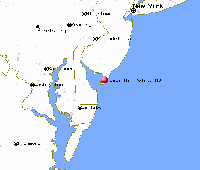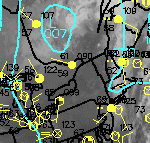
Fall's Journey South

Report Your Sightings

Teacher's Manual

Search Journey North

 A/CPB
A/CPBMonarch Migration Update: September 9, 1997
" I live less than 50 feet from Lake Ontario, on the 5th floor of an apartment building. I have enjoyed watching the thousands of Monarchs fly past my balcony--I can almost touch the butterflies as they glide past me. It is amazing how high they climb. I would love to know how they are able to find their way to Mexico??.."
August 28, Burlington, Ontario, Canada
Jacqueline Rimmer (rimmer@worldchat.com)
The monarch migration takes place without a single sound--all the way to Mexico--but it creates a great stir of excitement in the hearts and voices of people who witness it. Over the next weeks, we'll forward highlights of this fall's migration, as reported from people along the monarchs' path. We begin with the first notes from the north, where the migration began toward the end of August. Just this morning news arrived from further south, announcing that a wave of butterflies had arrived in Nebraska.
How to Report Your Sightings
Please keep your eyes on the skies and report monarchs you see in your region.
Also, let us know what you're doing to Unpave
the Way for Monarchs! To report your monarch sightings or news about your monarch
habitat project, simply press the owl button on the left and a Field Data Form will
appear.
Highlights Along the Trail
August 24 Minnesota
"An estimated 20,000 monarchs were nectaring at this blooming alfalfa field.
Surrounded by
Elizabeth Donnelly & Jim Hillegass, Minneapolis, Minnesota
August 28 Ontario
"On 28 August I witnessed perhaps the largest flight of Monarchs I've ever
seen. Approximately 1000/minute were coming ashore?.in 2 hours about 120 000 passed??"(More)
Bob Curry, Ancaster, Ontario. Credit: Leps-l (Lepidopterists' listserv)
August 31 Ontario
"Thousands of monarchs are gathering in the area and have been observed
along the north shore of Lake Ontario?." (More)
Sam Conroy, Trenton, Ontario
September 2 Minnesota
The first strong cold front of the fall hit Northern regions, and some interesting
observations were made: "There were between 500 and 800 butterflies here on
September 1st. Temperatures dropped late afternoon and the next day the butterflies
were gone?." (More)
Pari Ditmar, Glencoe, Minnesota
September 3 Iowa
Two days later, and 250 miles down the trail, Kathy Reed reported from Malvern,
Iowa: "Sept 3 was the first night we noticed monarchs roosting in our trees??
(More)
Kathy Reed, Malvern, Iowa
September 3 Ontario
The same cold front affected the migration sightings along Lake Ontario:
"The cold has greatly reduced numbers here since Wednesday (9/3/97). Last Thursday
(8/28/97) there were many migrants here. I found a roost of 300 or so?.and again
on Tuesday (9/2/97) there were another 300, most on exactly the same tree, exactly
the same branch?.." (More)
Rod Murray, Streetsville, Ontario
September 3 Ontario
"I have seen very few butterflies now. The odd one will fly by, as if in
no hurry. Our weather has changed quite a bit in the last couple of days. Tuesday
Sept. 2/97 the temperature was approx. 26c (79F). Today it is around 19c (66F)."
Jacqueline Rimmer Burlington, Ontario, Canada (rimmer@worldchat.com)
 |
| As a cold front pushes into Nebraska on September 8th, monarch sightings suddenly increase. Click weather map for a larger image. |
"What a difference a day makes! Yesterday, here and there a lonely Monarch was making the way south. Today as we left school there were nearly 200 monarch butterflies resting in the shade. We are having a cold front approach and some nasty looking storm clouds coming from the north ,so our butterflies should get a strong push south??" (More)
Gayle Kloewer, York, Nebraska
Generation Xtraordinaire
The monarchs you see today are the same butterflies we will track carefully next
spring, as they return from Mexico. The vivid colors of their fresh wings will be
faded after the long migration and winter months.
 This monarch generation is very long-lived
compared to the monarch generations of summer. During the summer, monarchs live for
only a few weeks. They quickly produce the next generation and die. In contrast,
monarchs of late summer do not enter the breeding condition. The shorter days and
cooler temperatures trigger a hormonal change, and the monarchs go into a state known
as "sexual diapause". Monarchs of this generation will live some 8-9 months--and
undertake a spectacular migration to Mexico in between.
This monarch generation is very long-lived
compared to the monarch generations of summer. During the summer, monarchs live for
only a few weeks. They quickly produce the next generation and die. In contrast,
monarchs of late summer do not enter the breeding condition. The shorter days and
cooler temperatures trigger a hormonal change, and the monarchs go into a state known
as "sexual diapause". Monarchs of this generation will live some 8-9 months--and
undertake a spectacular migration to Mexico in between.
In the spring, today's butterflies will become sexually mature. They will mate and
return to the southern part of their breeding range. It is their children who will
repopulate the north--and begin the cycle of summer generations again.
Coming Next Week
 |
| Location of Cape
May, New Jersey Why do you think Cape May is such a good place to watch for migrating monarchs? (See Challenge Question # 1 below.) Click map for a larger image. |
Try This!
Watch the weather in New Jersey closely this week! Check out the links below
to some of the best spots for weather-watching. Also, see if you can answer our first
Challenge Question of the season.
- Monarch Migration Project, Cape May, New Jersey
- Weather Map(Showing current wind direction, speed, & location of pressure fields.)
Challenge Question #1
"Why do you think Cape May is such a good place to watch for migrating monarchs?"
How to Respond to Journey North Monarch Challenge Question # 1
- Address an e-mail message to: jn-challenge-monarch@learner.org
- In the Subject Line of your message write: Challenge Question # 1
- In the body of the message, answer today's question:
Don't Forget!
Please include the name of your school and your location so we can credit you properly
for your answers.
The Next Monarch Migration Update Will be Posted on September 15, 1997







